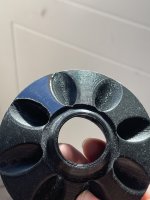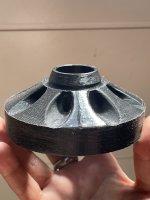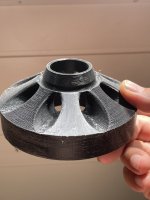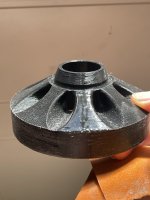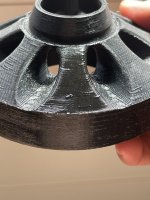0, 10 and 30 cm from the mouth, on axis.

I should also mention that no great care is given to the smoothness of the mounting and all the joints along the way. I just quickly attach the driver and proceed with that. In the end one would do a lot more to make sure everything is top notch.
I should also mention that no great care is given to the smoothness of the mounting and all the joints along the way. I just quickly attach the driver and proceed with that. In the end one would do a lot more to make sure everything is top notch.
Last edited:
So for now we have four different adapters available for the Lavoce DF10.171K:

So the exit angle mismatch has the biggest effect below ~2 kHz, apparently due to different strengths of the caused reflection.
Not matching the exit angle actually seems to lower the output around 1 kHz...
(The absolute SPL scale is not calibrated. I assume here that around 10 kHz the sensitivities will be the same in each case. Maybe they are not, but that's not how it appears.)
- The best I could measure the exit angle of the DF10.171K is 19.4°, STD-1 is 12° and the STD-2 is 31°.
What's missing is an extended throat with a ring plug. The EXT-1 has just a 1" input with a very small input angle, it's almost cylindrical.
So the exit angle mismatch has the biggest effect below ~2 kHz, apparently due to different strengths of the caused reflection.
Not matching the exit angle actually seems to lower the output around 1 kHz...
(The absolute SPL scale is not calibrated. I assume here that around 10 kHz the sensitivities will be the same in each case. Maybe they are not, but that's not how it appears.)
- The best I could measure the exit angle of the DF10.171K is 19.4°, STD-1 is 12° and the STD-2 is 31°.
What's missing is an extended throat with a ring plug. The EXT-1 has just a 1" input with a very small input angle, it's almost cylindrical.
Last edited:
How about a matched EXT adapter that starts with a 19.4° angle then morphs to a tube and at the end morphs to the correct exit angle?
I can try a simulation but it sounds like asking for trouble.
Or maybe like this (only a half shown):

Or maybe like this (only a half shown):
Last edited:
These are wild constructs. With the above it should be possible to even stop and hold the expansion with minimal additional reflections.
- With RCF NDX595 the EXT adapter is a bit smoother at the lower end (picture below). It has a smaller exit angle but I'm not sure it's that easy. There are also drivers with cylindrical exit - that would be pretty straightforward.

- With RCF NDX595 the EXT adapter is a bit smoother at the lower end (picture below). It has a smaller exit angle but I'm not sure it's that easy. There are also drivers with cylindrical exit - that would be pretty straightforward.
Last edited:
How about a matched EXT adapter that starts with a 19.4° angle then morphs to a tube and at the end morphs to the correct exit angle?
Actually, it's not so bad, probably worth a try -
(This is including the exit section of the driver.)
Directivity-wise, it would stay the same. That's still given by the "second throat".
Last edited:
Nice. This would also allow to experiment with various length of the middle tube and its influence on the frequency response.
Hard to say, this is similar to EXT-1, only shorter (the same length as the adapter above):

We're still missing the phase plug.
We're still missing the phase plug.
Thanks, that worked, sort of. So it seems the exit angle of the DF10.171K is more like 19.0 deg. Close enough.
BTW, here's anechoic data for 18Sound NSD1095N + A400G2:
(7ms window, 1/24 octave smoothing)
STD-1:

STD-2:

EXT-1:

BTW, here's anechoic data for 18Sound NSD1095N + A400G2:
(7ms window, 1/24 octave smoothing)
STD-1:
STD-2:
EXT-1:
Last edited:
The extension in the low end is very apparent in this set of graphs. It has been mentioned that the Lavoce DF10.172K has vented surround compared to the DF10.171K. (It also has a larger magnet.) Vented surround could mean softer suspension and lower Fs, which might be a plus for performance at the low end? (However on the datasheet the impedance peak is not lower in frequency.) Obviously it would be interesting to compare these drivers.
There's also the Celestion CDX1-1742 pretty much in the same category as the DF10.171K. There's also the Celestion CDX1-1412 which is a smaller, 35mm polyimide diaphragm neo driver. There's a photo here showing how the driver's exit looks like https://www.diyaudio.com/community/...sion-drivers-a-discussion.397699/post-7515387 not sure if interesting or not. There's also the Oberton D3644 which is surely the 1.5" exit version of the 1" D44/ND45 drivers, the larger exit diameter might be potentially interesting for custom plugs.
There's also the Celestion CDX1-1742 pretty much in the same category as the DF10.171K. There's also the Celestion CDX1-1412 which is a smaller, 35mm polyimide diaphragm neo driver. There's a photo here showing how the driver's exit looks like https://www.diyaudio.com/community/...sion-drivers-a-discussion.397699/post-7515387 not sure if interesting or not. There's also the Oberton D3644 which is surely the 1.5" exit version of the 1" D44/ND45 drivers, the larger exit diameter might be potentially interesting for custom plugs.
I will be getting the parts printed out of petg with 100μm layer thickness and solid infill (80%) via FDM. I will let you know how it turns out.@olegtern , @mabat and others who have recently printed these devices: any tips for printing, which filament and why? Are the prints resonant sounding when knocked or sufficiently damped so that there is no fear of the waveguide ringing? I guess PETG works fine? how about surface finishing? How to glue and with which glue that finishing doesn't get into a struggle?
If these are trade secrets then perhaps some gemeral tips for beginner? Thanks a bunch!
100μm is fine but will take a long time to print, perhaps unnecessarily. It could be 200μm with basically no loss of quality. I do 240 regularly with a 0.6mm nozzle (just the few last milimeters of the round tops I do sometimes thinner). The prints need finishing anyway and that smoothens out the layer traces. I also think that thicker layers make the prints stronger in general.
Looking forward to your results and findings about damping, 80% infill will make it pretty heavy and durable.
Looking forward to your results and findings about damping, 80% infill will make it pretty heavy and durable.
Last edited:
Uv-resin for printers and a soft brush is a really quick way of filling in the layer lines and make sure the print is 100% leakage free.
If one have the possibility to alternate between going in and out of a house, the sun is the quickest way of curing the resin.
But a uv lamp works too.
It’s also way easier to sand down smooth than the printed plastic, so a few coats with hardening, a quick sanding and a top coat can be done relatively quick.
If one have the possibility to alternate between going in and out of a house, the sun is the quickest way of curing the resin.
But a uv lamp works too.
It’s also way easier to sand down smooth than the printed plastic, so a few coats with hardening, a quick sanding and a top coat can be done relatively quick.
Last edited:
Here we go -Actually, it's not so bad, probably worth a try -
It states "matched" but I accidentaly set the input to 25.4 mm, in fact it is only 25.0 mm, so it's "matched" only to a degree.
It certainly doesn't cancel the output below 1 kHz, there are a few dB for the good.
BTW, it's shorter than the EXT-1. But we need to be able to control the expansion better...
Last edited:
First try with a Selenium D3300Ti, originally a 2" driver, here made effectively a 1.3" (which is the phase plug exit).
The original mounting flange can be removed and a Gen2 adapter easily made.
It's not bad at all, I actually quite like the results, for a 3" diaphragm.





The original mounting flange can be removed and a Gen2 adapter easily made.
It's not bad at all, I actually quite like the results, for a 3" diaphragm.
Last edited:
1.4" 18Sound ND3T, A520G2/36-STD-1

This one is really loud..
It probably won't get much better than this. Maybe some other NDx version. Can't buy them all.
This one is really loud..
It probably won't get much better than this. Maybe some other NDx version. Can't buy them all.
Last edited:
- Home
- Loudspeakers
- Multi-Way
- Acoustic Horn Design – The Easy Way (Ath4)
